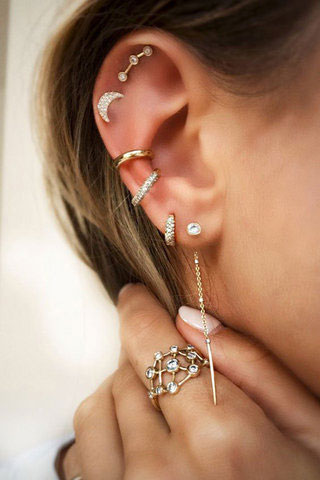Ear piercing allows you to wear beautiful jewelry and make incredible fashion statements. This procedure is often performed on little girls when they are still infants.
Does Ear Piercing Hurt?

There is physical pain associated with a piercing. To pierce the ears a hole or incision must be made in the ear. Anytime you cut or puncture a portion of your skin or cartilage there is going to be pain associated with the procedure.
Although piercing the ears is slightly painful it is said to be the least painful of all piercing locations.
The amount of pain you will experience is also directly related to the location you choose for the piercing.
Ear Lobes
The ear lobes are the least painful place to pierce. There is very little sensation felt in the ear lobe and it is relatively easy to numb the lobe using ice, or pinching pressure. This is the most frequently pierced place on the human body. People who have multiple piercings almost always get their first one in the ear lobe.
Cartilage
If you have multiple ear piercings then you are going to have to get the cartilage of the ear pierced. The cartilage is thicker and harder to pierce so it is also the location that presents with the highest level of pain during the procedure. Even in the cartilage of the ear establishing a hole for jewelry is less painful than the procedure is in any other area of the body.
How the Hole is Created

There are different methods used to pierce a hole or make an incision in the ear. The main two methods are via a needle that is manually inserted through the ear or a piercing gun that shoots the earring into the ear.
Needle Piercing
This type of piercing is done often. A needle is pushed through the ear section, usually the lobe, and then an earring is inserted into the hole that the needle creates.
The individual wears the earring until the wound has time to properly heal. The earring should be turned several times a day to make sure that the healing wound does not grow over the ear stud but remains open.
This method of piercing is probably a little more painful than the piercing gun method. The majority of people who have these piercings done will pinch their ear lobe until it becomes numb, and then push the needle through. They may also hold ice on the lobe until the lobe becomes numb.
A higher risk of infection is associated with this piercing style. The higher risk is caused by more amateurs doing the piercing at home and not taking proper precautions to sterilize the equipment or disinfect the ear before piercing.
Piercing Guns

These tools are used in malls, beauty parlors. Tattoo shops, and more places. The gun is a small piece of equipment that a piercing earring is loaded into.
Then the gun is positioned over the ear so that the earring will enter the ear at a pre-selected location. The person doing the piercing will squeeze the handle of the gun and the earring is shot out and penetrates the tissue.
This procedure is very fast. The recipient will experience a slight pain like someone just pinched them.
Less infections are associated with this style of piercing because the earrings that are used are new and usually sterile.
Beside Ear Piercing Check our Nose, Lip and Conch Piercing Post:
Best Nose Ring for Sensitive Skin
Best Mouthwash for Tongue Piercings Reviews
Caution
Before an ear piercing, or any piercing is performed you should NOT take aspirin. Aspirin works as an anticoagulant and can cause you to have a greater amount of bleeding.
You should consult your doctor prior to a piercing if you have any of the following health conditions:
- Hemophilia
- Diabetes
- Heart conditions
- An autoimmune disorder of any type
Check with your doctor and talk to the piercing specialist if you have any medical conditions that could cause the piercing to be dangerous for you.
Final Thoughts
Ear piercing is accepted in almost every country and throughout every social grouping. The piercing is done in both male and female ears.
Take the proper precautions to make sure your piercing will be safe. Proper aftercare of the pierced ear will help you to prevent infections. Follow the instructions the piercer gives you and enjoy your new look.

